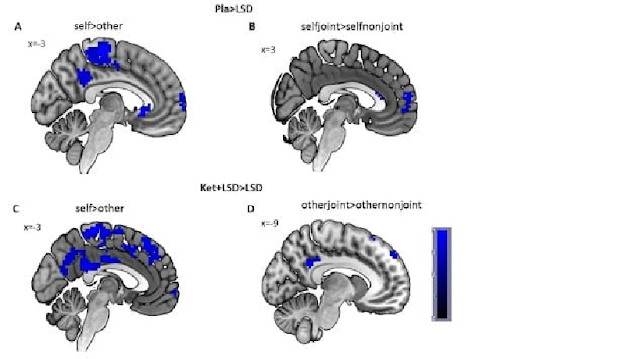L'LSD confonde i confini tra sé e gli altri. LSD confuses the boundaries between self and others.
L'LSD confonde i confini tra sé e gli altri. Il procedimento del brevetto ENEA RM2012A000637 è molto utile in questa applicazione. / LSD confuses the boundaries between self and others. The procedure of the ENEA patent RM2012A000637 is very useful in this application.
Segnalato dal Dott. Giuseppe Cotellessa / Reported by Dr. Giuseppe Cotellessa
Schematizzazione delle aree cerebrali attivate durante la sperimentazione con le diverse sostanze (Credit: Preller et al., JNeurosci, 2018) / Schematization of brain areas activated during experimentation with different substances
Scansioni di imaging cerebrale mostrano che sotto l'effetto dell'acido lisergico, le aree cerebrali che sovraintendono al senso del sé hanno un'attivazione alterata. Il risultato potrebbe rivelarsi importante per trattare i deficit d’interazione sociale in disturbi mentali come la depressione o la schizofrenia.
Il dietilamide-25 dell'acido lisergico, meglio noto come LSD, altera l’attività delle regioni cerebrali che permettono al soggetto di distinguere tra sé e le altre persone. Lo rivela un nuovo studio pubblicato sul “Journal of Neuroscience” da Katrin Preller e Franz Vollenweider, dell’Università di Zurigo, in Svizzera, e colleghi di una collaborazione internazionale.
L’LSD è una droga ben nota per i suoi effetti psichedelici. Causa nel soggetto un’alterazione dell’umore, della percezione di sé e della realtà esterna, come se i sensi fossero amplificati. Si tratta di una sostanza illegale, ma che viene usata in alcune sperimentazioni in ambito psichiatrico e psicoterapeutico.
Nel sistema nervoso centrale, l’LSD interagisce con i recettori di diversi neurotrasmettitori, ma gli effetti psichedelici sono riconducibili principalmente all’azione sul recettore 5-HT2A della serotonina, il cui funzionamento è alterato in in molti disturbi psichiatrici.
La ricerca di Preller e Vollenweider era focalizzata in particolare sul rapporto tra il recettore 5-HT2A per la serotonina e l’interazione sociale. I partecipanti sono stati suddivisi in tre gruppi, a cui sono stati somministrati LSD, ketanserin (un farmaco in grado di bloccare gli effetti dell’LSD) oppure un placebo. Una volta sotto l’effetto delle sostanze, i volontari hanno partecipato a un test basato su un “gioco di sguardi” con un personaggio virtuale dalle fattezze umane.
Durante il test, gli sperimentatori hanno analizzato il comportamento dei soggetti utilizzando due diverse tecniche: l’imaging a risonanza magnetica funzionale e il tracciamento del movimenti oculari. Il primo consente di visualizzare le aree cerebrali attive in un soggetto impegnato in uno specifico
L’analisi dei dati ha mostrato che durante il test nei soggetti sotto l’effetto dell’LSD l’attività della corteccia cingolata posteriore e della corteccia temporale era ridotta. Queste due regioni cerebrali sono importanti per stabilire il “senso del sé”: in sostanza, l’LSD rendeva molto più sfumata del normale la differenza tra la situazione del test in cui era il soggetto a decidere dove dirigere l’attenzione e quella in cui doveva seguire lo sguardo del personaggio virtuale.
Questi effetti erano bloccati dall’assunzione di ketanserin, il che indica che questo sistema recettoriale potrebbe essere la chiave per trattare i deficit d’interazione sociale in disturbi mentali come la depressione, caratterizzati da un’eccessiva attenzione verso di sé, o la schizofrenia, in cui c’è una totale perdita del senso di sé.
ENGLISH
Brain imaging scans show that under the effect of lysergic acid, brain areas that superintend the sense of self have altered activation. The result could be important for treating social interaction deficits in mental disorders such as depression or schizophrenia.
The diethylamide-25 of lysergic acid, better known as LSD, alters the activity of the brain regions that allow the subject to distinguish between himself and other people. This is revealed by a new study published in the "Journal of Neuroscience" by Katrin Preller and Franz Vollenweider, of the University of Zurich, Switzerland, and colleagues of an international collaboration.
LSD is a drug well known for its psychedelic effects. Cause in the subject an alteration of the mood, of the perception of the self and of the external reality, as if the senses were amplified. This is an illegal substance, but it is used in some trials in the psychiatric and psychotherapeutic field.
In the central nervous system, LSD interacts with the receptors of several neurotransmitters, but the psychedelic effects are mainly due to the action on the 5-HT2A receptor of serotonin, whose functioning is impaired in many psychiatric disorders.
The research by Preller and Vollenweider focused in particular on the relationship between the 5-HT2A receptor for serotonin and social interaction. Participants were divided into three groups, who received LSD, ketanserin (a drug that could block the effects of LSD) or a placebo. Once under the effect of the substances, the volunteers participated in a test based on a "game of looks" with a virtual character with human features.
During the test, the investigators analyzed the behavior of the subjects using two different techniques: functional magnetic resonance imaging and tracking of eye movements. The first one allows to visualize the active brain areas in a subject engaged in a specific one
task. The second allows to highlight on which points the subject's gaze is focused, and then on which objects his attention is focused.
The analysis of the data showed that during the test in subjects under the effect of LSD, the activity of the posterior cingulate cortex and of the temporal cortex was reduced. These two brain regions are important for establishing the "sense of self": in essence, LSD made the difference between the test situation in which the subject was deciding where to direct the attention and the one in which the subject was much more nuanced than normal. he had to follow the gaze of the virtual character.
These effects were blocked by taking ketanserin, indicating that this receptor system could be the key to treating social interaction deficits in mental disorders such as depression, characterized by excessive attention to oneself, or schizophrenia, in which there is a total loss of the sense of self.
Da:
http://www.lescienze.it/news/2018/03/20/news/lsd_confini_soggetto_altri-3906866/




Commenti
Posta un commento